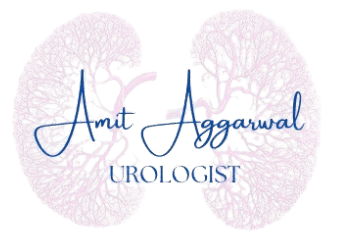What is a kidney stone?
Main function of your kidney is to remove excess water and waste products from your blood and make urine. A kidney stone forms when certain minerals separate out from the urine and forms crystals in your kidney that gradually gets larger in size with passage of time. Most kidney stones when very small in size travel through the urinary tract without being noticed or causing any significant pain. Sometimes they might get stuck in your ureters or urinary bladder or urethra and cause problems like pain, bleeding and urine retention.

They are mostly made up of calcium oxalates. Other types are uric acid, struvite also known as infection stones, phosphates, cystine, medications induced and other less common types.
Most of the time, an exact cause cannot be identified, and there is not a single cause which leads to stone formation. In general, it occurs mostly in people who consume less fluids, or due to dehydration in hot climates. It can also occur in people who consume lots of nuts, chocolates, berries, or coffee etc. as they have high content of oxalates. Risk also increases in those who are consuming excess of salt or high animal proteins, take dietary supplements like Vitamin C, or laxatives or antacids. People who are overweight or have chronic diarrhea or underwent some gastric bypass surgery, are also at increased risk of developing kidney stones. People who have a family member who had kidney stone earlier are also a slightly higher risk of developing stones.
Yes kidney stones are notorious to recur. Even if someone has taken treatment or passed out stones in urine on their own or underwent some surgical procedure for removal of stones, they can still recur. Almost 50% patients can redevelop stones in next 10 years. Sometimes in less than 5% of cases, in a condition known as hyperparathyroidism, the parathyroid gland can secrete excess hormones which can increase risk of stone recurrence. Treatment of this condition can generally halt the recurrence.
A kidney stone usually will not cause symptoms until it moves around within your kidney and passes into your ureters. If it becomes lodged in the ureters, it may block the flow of urine and cause the kidney to swell and the ureter to spasm, which can be very painful. At that point, you may experience severe sharp pain in the sides and back, below the ribs which might radiate to lower abdomen or groin area, or burning sensation while passing urine. Other symptoms might be blood in urine or foul smelling or cloudy urine or passing urine very frequently. In severe cases, fever with or without chills or excessive vomiting might also occur. Sometimes, stones can be a silent one and only detected on routine health checkup – “Silent Stone”.
Once you visit your urologist, certain blood tests like CBC, KFT, serum calcium, phosphate, uric acid, blood sugars levels, viral markers and coagulation profile are performed. Urine routine tests and urine culture sensitivity are also done to look for any urinary tract infection. An ultrasound or plain CT scan of your kidneys, ureter, bladder region (NCCT KUB) are generally required to locate the stone and know its size, hardness, number and swelling in kidneys etc. so that accordingly treatment can be planned.
In people who need some surgical procedure, additional tests like chest X ray, ECG etc. may be needed for anaesthesia fitness as deemed necessary by the anaesthetist.
In people who have repeated stone formation some additional tests like serum parathormone level and 24 hrs urine analysis for calcium, uric acid, oxalates, phosphates, citrates, magnesium etc. and arterial blood gas analysis are also done. These tests are usually done 3 to 4 weeks after all stones have passed out or have been removed surgically.
Painkillers are usually prescribed initially only to relieve pain, however until and unless the patient passes the stone spontaneously or gets it removed by a urologist, the pain is likely to recur. For every small ureteric stone, sometimes a special medicine alpha blocker is prescribed for 1 to 2 weeks.
However, if the stone size is larger than 6mm, either ESWL, URS, PCNL, RIRS, CLT might be advised. If there is any evidence of severe infection clinically or on urine or blood tests and then antibiotics either in tablet form or injectable maybe prescribed with or without PCN /DJ stent.
ESWL is a non-invasive treatment carried out under local anesthesia on a daycare basis for kidney stones less than 1.5 cm that are not very hard and some upper ureteric stones. These stones must be visible on plain X-ray for this procedure. It involves the administration of a series of external shockwaves which are generated by machine called lithotripter to the targeted stones.
Ureteroscopy is a minimally invasive technique involving the passage of a very thin semirigid endoscope through the urethra and the bladder into the ureters up to the place where stone is located. The stone is then either grabbed and removed with forceps, if small or else it is fragmented and removed or it is dusted and made into sand like particles that pass out in the urine in a few days. Ureteroscopy is usually performed under general anaesthesia, and the procedure usually lasts from 30 to 60 minutes. Sometimes, if the stone is stuck, very hard or there is pus inside, or the ureter is very tight not allowing the insertion of the endoscope, then only a Double J stent is placed and the definitive procedure is performed after 7-10 days. This is done to reduce complications, like ureteric injury, sepsis, etc. and keep patient safety in mind. Staged ureteroscopy usually does not need DJ stent insertion at the time of stone removal. However, the final decision for stenting is done at the time of ureteroscopy.
Discharge is usually done the next day if there is no fever. Patients who are on Double J stent may experience some loin pain, frequency, urgency, slight burning urination, or slight blood at the end of urination. These symptoms are however temporary and resolve after stone removal.
Patients have to get readmitted on a day-care basis after 10-14 days to get the stent removed under local anaesthesia which again is an endoscopic procedure of 5 min duration.
PCNL involves making a small keyhole incision (0.5-1cm) cut on your back and creating a small tract with the help of a guidewire and small dilators into the kidney. The endoscope is then passed and the stone is visualized and broken with either laser or another device known as Lithotripter. All the pieces are removed under the vision and confirmed through an X-ray for any residual stones.
In case of a large stone load or complex stones, a repeat PCNL may be needed before a patient is completely stone free. There is always some risk of bleeding, infection, adjacent organ injury, however all of them can be safely managed most of the time. The nephrostomy tubes and urine catheter are removed and discharged by day 2 after the surgery. You may have a burning sensation when passing urine after the catheter is removed. This, if required can be relieved with medication or increased intake of water.
The Double J stent is removed after 2 weeks on a day care basis using a flexible endoscope and the patient is discharged the same day.
This is a minimally invasive procedure that utilizes special equipment known as flexible ureteroscope to access all portions inside the kidney. It is typically used to access all portions inside the kidney. It is typically used for stones that are lesser than 1.5 cm, or to remove some residual stones after previous surgery or ESWL, or for stones that are not visible on plain X-ray or for patients who are on blood thinners and due to some reason cannot be stopped. This procedure is generally a two-stage procedure in which the first sitting involves placement of only double J stent so that the ureters can dilate and the next sitting is performed after 7-10 days that involves the actual process of breaking and removing the stone which may or may not need stent replacement depending upon the operative findings and surgeon’s decision. Discharge is usually done on the next day if it is an uneventful recovery. If the stent is placed in the second sitting, it is then removed after 2 weeks a day care procedure. In some conditions, like in patients whose ureter is very wide, even single sitting RIRS is also possible however it depends on a case-to-case basis.
These are minimally invasive treatment options for bladder stones. Depending on the size and number of stones, either the endoscopy is done from the natural passage i.e, urethra and the stone is broken with laser/lithoclast, if the size of stone is less than 2 to 3 cm. However, for larger stones, a small puncture is done just above your pubes and the tract is dilated till bladder followed by endoscopic removal of the stone.
Why Choose Dr. Amit Aggarwal for Urinary Stone Disease?
Dr. Aggarwal is a leading urologist specializing in stone management. With years of experience and a reputation for compassionate care, Dr Aggarwal offers advanced diagnostic tools and treatments to help patients achieve their treatment. Dr Aggarwal works closely with each patient to offer customized solutions and support throughout their treatment journey.
Don’t let urinary stone stand in your way. Contact Dr Amit Aggarwal today to discuss your symptoms and explore the best treatment options for you.





